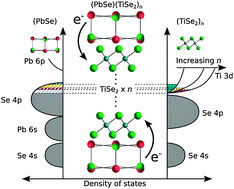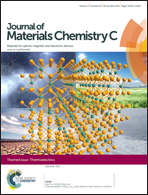Carrier dilution in TiSe2 based intergrowth compounds for enhanced thermoelectric performance
Abstract
Synthesis and electrical properties of kinetically stabilized (PbSe)1+δ(TiSe2)n thin-film intergrowths are reported for 1 ≤ n ≤ 18. A linear increase in the c-lattice parameter of the intergrowth is observed as n is increased and the slope is consistent with the inclusion of an additional TiSe2 structural unit as n is incremented by 1 and the observed intercept is consistent with the expected thickness of a PbSe bilayer. The charge donated to the TiSe2 constituent from the PbSe is diluted across more layers as n is increased, leading to a systematic increase in the Seebeck coefficient. The room temperature resistivity values of the reported compounds are all on the order of 10−5 Ω m and depend on defect densities that affect the mobility, making the magnitude of the resistivity less sensitive to n. The temperature dependence is metallic for large n, with a slight upturn at low temperatures due to localization of carriers for small n values. The power factor increases with n, including the highest reported for chalcogenide misfit layered and related compounds, showing that nanostructuring and modulation doping are an effective means of tuning the power factor of thermoelectric intergrowth materials. Since these compounds have very low thermal conductivity due to structural anisotropy and misregistration between intergrowth constituents, this suggests that varying their nanoarchitecture is a promising approach to obtain high values of zT.

- This article is part of the themed collection: The Chemistry of Thermoelectric Materials

 Please wait while we load your content...
Please wait while we load your content...